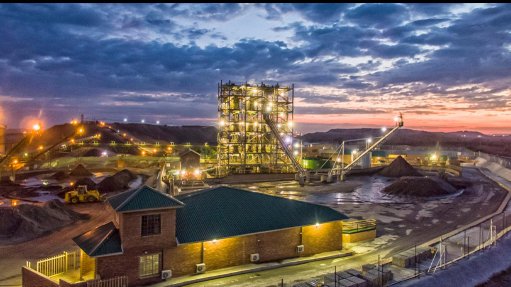
Name: Kroondal mine.
Location: Kroondal is situated in Rustenburg, in South Africa’s North West province.
Mine Owner/s: The Kroondal mine is a 50:50 joint venture (JV) between Sibanye-Stillwater and Anglo American Platinum, and is subject to a pool and share agreement, whereby the Sibanye-Stillwater infrastructure is used to access mineral resources on the Anglo American Platinum held mining right. The JV is managed by Sibanye-Stillwater.
Brief History: Kroondal started operations in 1999 and has been progressively expanded since that time. The operation has a mine life to 2030.
Brief Description: Kroondal exploits the upper group two (UG2) reef. It comprises established shallow, mechanised platinum group metals (PGMs) operations in the western limb of the Bushveld Complex.
The mine is large and established with all the necessary surface infrastructure to support mining operations.
Apart from the five operating shafts, Kwezi, K6, Kopaneng, Simunye and Bambanani, it hosts five shafts under care and maintenance, in the Marikana area.
Primary Metals: 4E – platinum, palladium, rhodium and gold and 6E– platinum, palladium, rhodium, iridium, ruthenium and gold.
Secondary Metals: None stated.
Geology/Mineralisation: UG2 Reef is exploited at Kroondal operations, which comprises two chromite-rich horizons hosting PGM minerals, separated by a pyroxenite, parting forming the mineable horizon. The reef dips at about 9º towards the north-east.
The two chromitite horizons, termed the UG2 leader seam and the UG2 main seam, are about 20 cm and 70 cm thick respectively, and the pyroxenite parting has a variable thickness of up to 4 m, but is typically less than 1.5 m.
The mining cut typically includes both seams, and the minimum mining width is 200 cm and the maximum is 270 cm, which includes the internal pyroxenite.
The orebody is tabular, laterally continuous with relatively long-range grade consistency and predictability.
Reef disruptions in the form of potholing, faulting, IRUP and dykes occur throughout the orebody, resulting in an average geological loss of about 15%.
Reserves: Total proven and probable reserves as at December 31, 2018, were estimated at 18.4-million tonnes grading 4E at 2.6 g/t and 6E at 3 g/t.
Resources: Total mineral resources as at December 31, 2018, were estimated at 46.2-million tonnes grading 4E at 3.2 g/t and 6E at 3.8 g/t.
Mining Method: Bord-and-pillar.
Major Infrastructure and Equipment: The Kroondal deposit is accessed from surface using decline systems. Mining takes place at depths from 250 m to 55 0m below surface.
Run-of-mine ore is treated using two concentrator processing plants (K1 and K2) and there is spare processing capacity at a third concentrator plant, which is currently under care and maintenance (Marikana plant).
Currently ore from the Kwezi, Simunye and Bambanani shafts is processed at K2 and from the K6 and Kopaneng shafts is processed at K1.
Prospects: It is estimated that the current mineral reserves will sustain the Kroondal operations until 2030. Studies are ongoing to optimise chrome extraction using improved technology.
Contact Details:
Sibanye-Stillwater
Tel +27 11 278 9600
Email ir@sibanyestillwater.com
Website https://www.sibanyestillwater.com